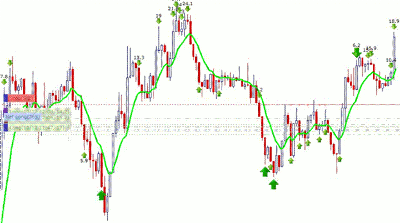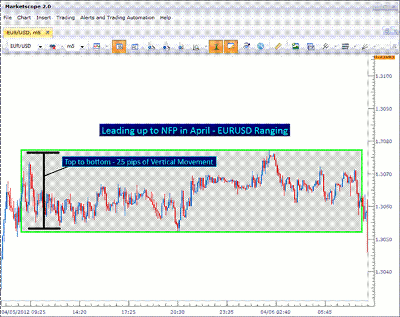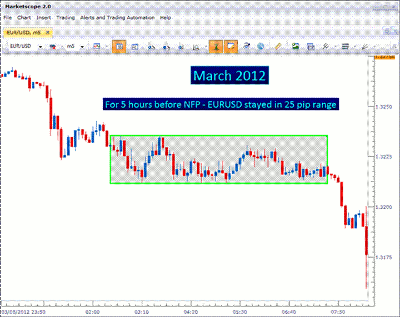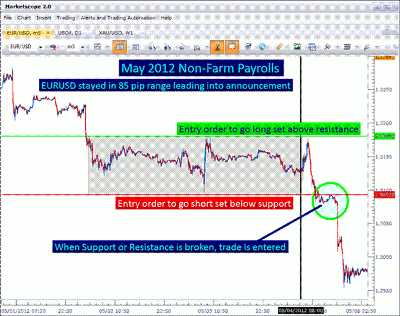This five-step process is designed to help forex traders assess market conditions and ensure proper risk management when trading risky but potentially lucrative news and economic reports, writes James Stanley of DailyFX.com.
Trading news announcements like non-farm payrolls can be dangerous, and anyone going into a news release without fear of how badly an account can be ravaged by volatility should probably avoid doing so, and instead wait for quieter markets.
But, to the trader who always protects their downside, adheres to strong money management, and protects their account by avoiding the number-one mistake forex traders make, news announcements can offer compelling opportunities for a lot of movement in a very short period of time.
Watching price action can assist greatly in the initiation of trades, and this movement and volatility can bring a significant amount of pips to a trader’s account.
Rampant volatility that can typify news releases can deplete a trading account quickly if trades around news events are not handled properly.
What follows is one of the more common ways traders can look to trade the news regardless of which way the announcement comes out, but before we get into that, let’s establish a couple of important points.
- Nobody can tell the future (which is why risk management is so important in the first place)
- We will likely never know what the news will be before the release (see #1 as to why)
Even if we did know what the news announcement would be, we still don’t know exactly how the market will react to this news.
To sum it up, trading news announcements adds additional volatility to the trader’s charts. By many accounts, trading news is very similar to trading in “panic” situations. The more important the news announcement, the more potential volatility that may enter into the market and the more similar to a “panic” situation that news release is.
See also: Trade Headlines without Becoming One
An announcement like non-farm payrolls (NFP) can bring some significant movement, as much of the world is watching this figure for signs of future direction.
Step 1: Observe Price Leading into the Announcement
At 8 am ET, approximately 30 minutes before the NFP announcement, the trader can plot support and resistance based on price action. This can be done by observing the past few hours immediately prior to the release, and drawing a rectangle around the high and the low that was hit during this period. This can be done on the five-minute, 15-minute, or even one-minute charts—the high and low of this time period will be the same.
If looking for maximum movement, often one of the major currency pairs (any currency with USD in it) will suit that need. If looking for a more conservative approach, cross pairs can certainly work as well (pairs without the US dollar).
Below is a chart of the most popular currency pair in the world, the EUR/USD, for the 14 hours leading into an NFP report:
NEXT: Step 2: Identify Support and Resistance
|pagebreak|Step 2: Identify Support and Resistance
As you can see, for 14 hours leading into the NFP report in April 2012, price respected a 25-pip range. The reasons for this can be numerous, but key amongst them is the fact that liquidity providers and market makers that set the prices for which we can execute our trades are cautious of NFP as well.
They fully realize that a surprising number can spark a rally or a selloff in a very short amount of time. And, leading into the announcement, any significant positions taken on (by liquidity providers or retail investors executing trades) bear significant risk.
Below is a chart of EUR/USD ahead of the March NFP report. Notice the same type of phenomenon takes place here, as the market stays range bound leading into the announcement.
Step 3: Set Entry Orders
Now that we’ve plotted support and resistance based entirely around the price action taking place leading into an announcement, we can begin to set our game plan.
The one thing we know for certain going into a news announcement is that there will probably be volatility. Predicting which direction that volatility may move is what makes trading news difficult, but we don’t need to know the direction that volatility will push prices, as we can set entry orders on either side of support and resistance. The picture below will illustrate that concept more fully:
NEXT: Step 4: Manage Your Order Efficiently
|pagebreak|Step 4: Manage Orders
What if price comes down to open up our short position and then moves directly back to prior resistance to trigger us in a long position?
For traders in the United States, where first-in/first-out (FIFO) execution is the standard, it may close out our short position at a loss. So going into the trade, you have to know how you would want this situation handled.
If you would like the entry order to go long to be canceled as soon as the short position is entered (or vice versa), you can set a One Cancels Other, or OCO order. That way, when the short position is entered into, the long entry gets canceled. This can be done very easily from the FXCM Trading Station platform (and most every currency trading platform out there).
After all orders are entered, you can click on the tab for “Trading” on the platform, then choose “Orders,” followed by “Complex OCO.” Doing so will bring up the following box:
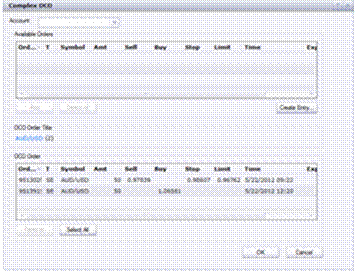
Initially, all entry orders will show in the top box. We can simply highlight the orders we want to be part of the OCO order (or clicking on “select all” will select all available orders), followed by the button below the top box and to the left for “Add.”
Step 5: Add Stops/Limits
Because we are anticipating volatility during a fast-moving environment, it benefits us to add proper risk management parameters in our trades.
We have to keep in mind that the number-one mistake forex traders make is risking too much to make too little. Despite lofty winning percentages, that type of inverse risk/reward ratio doesn’t allow for much long-term success.
Directly from the Traits of Successful Traders series compiled by DailyFX, David Rodriguez states:
“Traders are right more than 50% of the time, but lose more money on losing trades than they win on winning trades. Traders should use stops and limits to enforce a risk/reward ratio of 1:1 or higher.”
Because we have identified support and resistance previously when setting up our entry orders, we can look to place our stop on the other side of the range. So, for the short entry looking for breaks of support, stops can be placed slightly above resistance. And, for the long entry hoping for breaks of resistance, stops can be placed slightly below support.
Also, profit targets or limits should be, at minimum, 100% of that amount. If you are risking 50 pips on the trade idea, look for a minimum of 50 to make sure that is worth your time. Many traders will actually look for much more than the number of pips risked, seeking a much higher risk/reward ratio, such as 1:3 (50 pips risked, 150 pips sought) or even 1:5 (50 pips risked, 250 pips sought).
See also: Make Sure Risk/Reward Is on Your Side
By James Stanley, instructor, DailyFX.com

